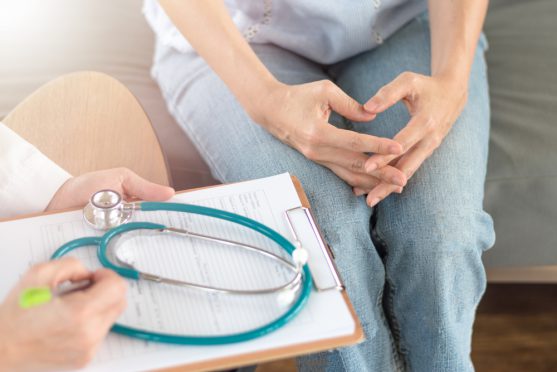Cervical cancer is one of the most common cancers in women. It occurs when the cells lining the cervix undergo mutation and begin to grow uncontrollably.
Globally, every year about half a million women are diagnosed with cervical cancer, and over 3,00,000 resultant deaths are reported. In the year 2018, about 5,70,000 cervical cancer cases were diagnosed and about 3,11,000 deaths were reported.
However, since the introduction of screening tests, the incidence and mortality of cervical cancer have decreased by more than half in developed countries.
Every treatment has its side effects, likewise, the cervical treatment also has its side effects depending upon the modality used.

The side effects can be acute which appear during or immediately after treatment. Long-term side effects usually appear gradually, long after completion of the treatment. Here, we would discuss only the acute side effects and their management.
Different modalities used to treat cervical cancer
Cervical cancer treatment is complex and requires a multidisciplinary approach. Depending on the overall health, age, and extent of cancer at the time of diagnosis, cervical cancer can be treated with the following treatment modalities.
-
- Surgery
- Radiation therapy
- Chemotherapy
- Targeted therapy
- Immunotherapy
Treatment options for cervical cancer
Stage IA1
At this stage, the cancer is localized in the cervix. The treatment is considered based on whether the woman wants to preserve fertility or not and whether the cancer has spread into blood and lymph vessels.
The treatment modalities at this stage include:
- Cone biopsy with or without removal of the lymph nodes in the pelvic area
- Radical trachelectomy to remove the cervix, the upper part of the vagina, the surrounding tissues and the lymph nodes in the pelvic area
- External beam radiation therapy (EBRT), followed by brachytherapy
- Radical hysterectomy (removing uterus plus both ovaries) with removal of the pelvic lymph nodes
Stages IB1 & 2 and IIA1
The cancer in these stages is localized to the cervix and upper vagina and has not spread to the nearby lymph nodes.
Treatment for cervical cancer at this stage can be done with:
- Radical hysterectomy and pelvic lymph node dissection with or without radiation therapy to the pelvis along with chemotherapy
- Radiation therapy with concurrent chemotherapy
- Radical trachelectomy (fertility preservation)
- Only radiation therapy
Stages IB3, IIA2, IIB, III, and IVA
The cancer in these stages is locally advanced and might also have spread to nearby lymph nodes and pelvic organs.
The treatment at this stage may include:
- Radiation therapy with chemotherapy
- Brachytherapy
Stage IVB
The cancer in this stage has become metastatic and spread to distant body parts.
The treatment modalities at this stage may include:
- Chemotherapy
- Radiation therapy, with or without chemotherapy, to relieve symptoms
- Targeted therapy with chemotherapy or immunotherapy alone
Recurrent cervical cancer
For cervical cancer that has come back after successful treatment, the following treatment options may be considered depending on the extent of disease & previous treatment received:
- Radiation therapy and chemotherapy
- Pelvic exenteration surgery
- Chemotherapy alone or in combination with targeted therapy or Immunotherapy to relieve symptoms and improve quality of life
- Drugs under clinical trial alone or in combination with other treatment modalities
Surgery and its side effects
The main aim of cancer removal surgery is to remove all the cancer cells without causing any much damage to the surrounding healthy tissues.
In most cases, the patient may receive radiation therapy and chemotherapy after the surgery to destroy the remaining cancer cells depending upon the risk features on surgical specimen.
Cervical cancer in its very early stages can be removed through cryosurgery (creating freezing temperature by using liquid nitrogen, to destroy the cancer cells) or laser surgery (using high-energy beams to burn and destroy the cancer cells).
These minor procedures may cause side effects such as:
- Pain
- Tiredness
- Vaginal bleeding or watery discharge
- Cramps, usually due to the tissue damage

These side effects are mild and may subside on their own.
Some women may have to undergo a procedure called LEEP (loop electrosurgical excision procedure), also called conization. In this procedure, electric current is passed through a thin wire to excise the cancer tissue.
Women who have stage 1 cervical cancers may need to undergo removal of cervix with surrounding lymph nodes (radical trachelectomy) or removal of the uterus (hysterectomy).
After any of these procedures, they may experience:
- Pain for a few days to 2-3weeks
- Tiredness
- Vaginal bleeding or some watery discharge for a few days
- Cramps
- Difficulty in passing urine (increased frequency, incomplete evacuation) or rarely bowel movement
- Risk of blood clots in lower limbs
- Risk of infections, especially at the incision site.
The surgery may involve a very mild risk of damage to nearby organs, like the bladder, ureters, or rectum.
Trachelectomy, usually performed in women with early cancers who wish to preserve the uterus for bearing a child, may lead to long term problems such higher risk for miscarriage and pre-term delivery.
Women who undergo hysterectomy cannot become pregnant.
You can read more about pregnancy after cervical cancer treatment here.
Radiation therapy
Radiation therapy uses high-energy radiation beams to destroy cancer cells. For treating cervical cancers, radiation therapy can be given in two ways:
External beam radiation therapy (EBRT)
In this type of radiation therapy, the radiation beams are passed onto the cancer from a machine present outside the body.
For cervical cancer treatment, the radiation therapy is usually combined with low-dose chemotherapy.
Brachytherapy (Internal beam radiation therapy)
In this type, a device containing a radioactive source is placed in the vagina or the cervix to kill the cancer cells without causing much damage to the surrounding tissue.
In cervical cancer, brachytherapy may be combined with EBRT.
Radiotherapy for cervical cancer can cause side effects, which may manifest during or immediately after radiotherapy (acute) or many weeks, months or even years (delayed) after radiotherapy.
The acute side effects include the following:
Fatigue
Radiotherapy can cause many chemical changes in the body that may manifest as fatigue. In addition, dehydration may contribute to fatigue if the fluid intake is not taken care of.

Stay hydrated to manage fatigue
Bladder and bowel problems
Increase in frequency, urgency, or burning sensation are common side effects, and may subside with time.
Increased motility, watery stools or even constipation can happen as a side effect of radiation therapy.
Skin problems
Due to radiotherapy, the skin may appear red, and sore, and may even peel off leaving raw areas.
Hair loss
The pelvic area that received radiotherapy, may lose hair, including the pubic area; it may grow back after the treatment.
Vaginal discharge
There may be unusual vaginal discharge, and can be blood-stained or foul smelling.
There could be some delayed effects of radiotherapy and may include the following:
Lymphedema
The radiation can affect the drainage of lymph fluid causing its accumulation in the legs, leading to swelling.
Bladder and bowel problems
Bladder and bowel issues mentioned above may even arise months or years after completing the radiation.
Vaginal narrowing
Radiation therapy may cause the vagina to narrow down, as a result, sexual intercourse or pelvic examination may become painful or uncomfortable.
Menopause
If the ovaries are removed, or are severely affected by the radiotherapy, you may no longer produce hormones, resulting in menopause.
Chemotherapy
It uses specific drugs either alone or in combination to destroy the cancer cells. Most often these drugs are given orally or administered in the form of intravenous injection.
The following are the common acute side effects associated with chemotherapy:
- Nausea
- Vomiting
- Loss of appetite
- Hair loss
- Mouth sores
- Fatigue
Immunotherapy
It uses certain medicines to boost a person’s immune system in order to identify and kill the cancer cells.
The following are the acute side effects of immunotherapy
- Fatigue
- Fever
- Headache
- Diarrhoea or constipation
- Loss of appetite
- Nausea
- Skin rash
Targeted therapy
It involves the use of drugs or other substances to target specific genes, proteins, or tissues that contribute to the growth of cancer cells.
These drugs inhibit the growth and spread of cancer cells without damaging the surrounding tissues.
High blood pressure, fatigue, and nausea are a few common side effects of targeted therapy.
Managing the common side effects
The following tips can help in managing some common side effects of cervical cancer treatment effectively.
Diarrhoea
- Drink at least 8 to 12 glasses of water and adequate fluids, such as fresh fruit juices to manage dehydration caused by diarrhoea.
- Avoid high-fat and greasy foods.
- Eat sodium and potassium-rich foods.
- Eat a low-fiber diet.

White bread is low fibre and can ease diarrhoea
- Avoid chewing gum.
- Do not consume alcohol, stop tobacco products and caffeine-containing products, such as coffee, tea, soda.
Constipation

Oats are high fibre and can reduce constipation
- Have a fiber-rich diet.
- Stay hydrated by drinking plenty of water.
- Do gentle exercises, such as walking to improve bowel movement.
- Use laxatives with doctor’s advice.
Nausea and Vomiting
- Take anti-nausea medicine as prescribed by the doctor.
- Drink lots of water or fluids.
- Do not eat greasy, fried, and sugary foods.
- Avoid eating or drinking before or immediately after the cancer treatment.
- Distract yourself from the feeling of nausea.
- Try peppermint candy or ginger candy to reduce nausea.

Ginger can reduce nausea
Fatigue
- Do light to moderate exercise daily to make you feel better and energetic.
- Take adequate rest by sitting or just lying down. However, do not overdo it.
- Have a healthy and well-balanced diet.
- Do meditation and yoga.
- Take massage therapy.
- Take nutritional counselling.

Yoga can help with fatigue
Hair loss
- Protect your scalp from cold, sun damage, and other environmental pollutants.
- Avoid making a ponytail or a braid.
- Use a silk or satin pillowcase to reduce hair from coming out in clumps.
- Use a wide-toothed hair brush to comb your hair.
- Avoid too much brushing or pulling hair.
- Do not use shampoo that has strong fragrance, alcohol, and salicylic acid.
- Consider buying a synthetic wig.
Loss of appetite
- Consider eating several small meals the whole day, instead of three large meals.
- Do not drink liquids while having meals.
- Stay physically active.
- Eat high-calorie and protein-rich snacks.
- Have your favourite foods at least once a day.
Skin problems: rashes, dry and itchy skin
- Use a mild soap and warm water to clean the skin.
- Use mild moisturizers or lotions to keep the skin moisturized.
- Take necessary precautions to protect your skin from heat and cold.
- Prevent sun exposure.
- Add a few drops of baby oil to warm bath water.
- Wear soft and loose-fitted clothes.
- Try adding baking soda, oatmeal, or baby oil to bath water to prevent itching.
- Make sure your room is cool and well ventilated to avoid sweating.

Moisturize your skin
Bladder and Bowel incontinence
- Do not hold urine or stools for too long.
- Empty the bladder before sleeping or after performing any strenuous activity.
- Do not drink alcohol or caffeine-containing products, such as coffee, tea, soda.
- Avoid using hygiene care products to avoid the risk of infections.
- Maintain a healthy body weight.
- Do not smoke or use any tobacco products.
- May require medical care if the symptoms persist.
Vaginal dryness
- Use a water-based gel lubricant.
- Apply vaginal moisturizers for a few days.

